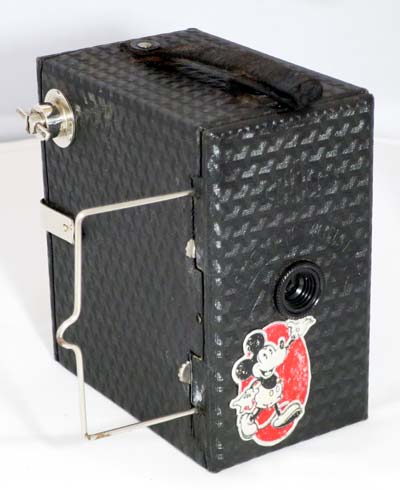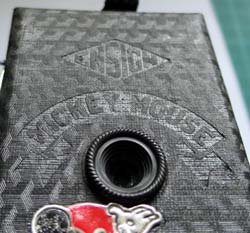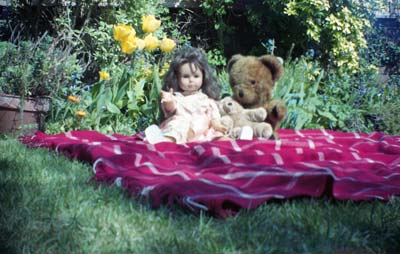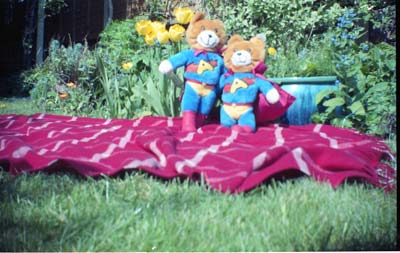Ensign Mickey Mouse
Specification

| Manufacturer | : | Houghton-Butcher |
|---|---|---|
| Produced | : | 1935 |
| Classification | : | Miniature |
| Body Type | : | Box |
| Construction | : | Wood |
| Film Type | : | M10 Rollfilm |
| Film Width | : | 35mm |
| Image Size | : | 1⅝ x 1¼ |
| No. of Images | : | 6 |
| Lens Type | : | Meniscus |
| Focus Type | : | Fixed |
| Focal Length | : | 60mm |
| Focus Range | : | 10ft to inf. |
| Aperture Type | : | Fixed |
| Aperture | : | f/18 |
| Shutter Type | : | Rotary |
| Shutter Speeds | : | B,I*(1/50 sec) |
| Size (w x h x d) | : | 60 x 87 x 83 mm |
| Weight | : | 130g |
| * Measured on this camera | ||
Art Deco Credentials
![]()
![]()
![]()
![]()
Significant: Pronounced and self evident
- Produced during the main Art Deco period;
- Repetative geometric pattern on body covering;
- Chrome highlights on winder and door catch;
- Ensign and Mickey Mouse embossed on covering;
- Mickey Mouse foil decal.

Description

The Ensign Mickey Mouse Box camera is a very small camera only 9cm high. It is made from wood. The name 'Ensign' is embossed in a diamond on the front as well as the 'Mickey Mouse' name embeded in a ribbon shape. The synthetic covering has a repetative geometric pattern. There is a foil decal of Mickey himself on the front below the lens. It is difficult to find and example of this camera with a decent foil Mickey as well as an intact strap.
It uses special M10 film which is similar to Ensign's E10 rollfilm. It takes six 1⅝ x 1¼ images. It is fitted with a simple and rather ineffective wire frame viewfinder.
It has a fixed focus meniscus lens. Shutter has two settings: instant or time, although the time setting is more like 'bulb'. Frame advance is achieved using a tommy bar winder and registration of the frame is via a red window.
Both the camera and film were made by arrangement with Walt Disney Mickey Mouse Limited.
How to Use
This camera takes M10 film which is no longer available. The spools are 36mm wide so it is possible to use 35mm film with some backing paper. You could make your own film by cutting down 120.
As the shutter speed is only 1/50s, it is advisable to use a tripod to get clear shake free images. However, holding it against a wall or other solid object would work as well. For quick snapshots, hold it firmly against your body.
If you don't want to bother with an exposure meter, follow the guide shown. It is based on the 'Sunny 16' rule. Film is so forgiving and will produce acceptable results even when overexposed by 2 or 3 stops or underexposed by 1 stop.
The tables assume that the sun is at least 30 degrees above the horizon - that's 10am - 5pm on a summers day (May - August) in the UK.
Remember that the exposure guide in the manual may not be helpful as it is based on the use of old film with a low ISO value.
Using ISO 100/125 film - shutter speed 1/50s
| Weather Conditions | Shadow Detail | Aperture | Exposure |
|---|---|---|---|
 Sunny SunnySnow/Sand | Dark with sharp edges | f/18 | +1½ Stops Overexposed Acceptable |
 Sunny Sunny | Distinct | f/18 | ½ Stop Overexposed Acceptable |
 Slight Overcast Slight Overcast | Soft around edges | f/18 | -½ Stop underexposed Acceptable |
 Overcast Overcast | Barely visible | f/18 | -1½ Stops Underexposed Not Acceptable |
 Heavy Overcast Heavy Overcast | None | f/18 | -2½ Stops Underexposed Not Acceptable |
 Open Shade Open Shade/Sunset | None | f/18 | -3½ Stops Underexposed Not Acceptable |
Photographs taken with this Camera
Kodak Portra 160 film cut down to 35mm. Developed in Tetenal

